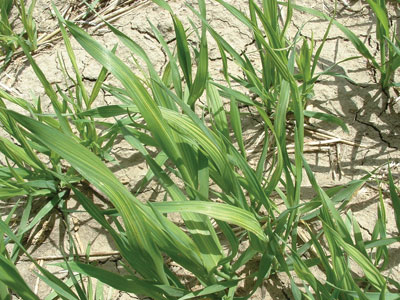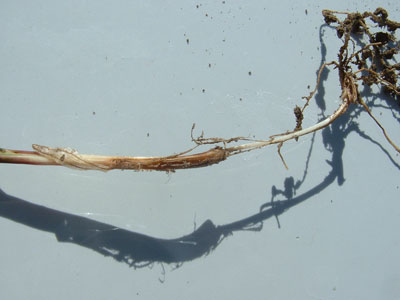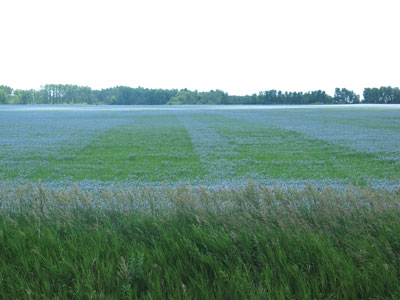
Features
Agronomy
Other Crops
Solving weak cereal vigor problems
While 2008 ended up being a banner crop year for many growers across the south, it did not start out that way.
May 1, 2009 By Bruce Barker
While 2008 ended up being a banner crop year for many growers across the south, it did not start out that way. Early seeding of cereal crops followed up by a long, cold spring resulted in a slow start and poor crop vigor in the early going. “The cereals started slow but ended up fantastic for a lot of growers. Things didn’t look quite so good to start with though,” says Keith Mills, Manager of Agronomic Services with Viterra at Lethbridge, Alberta.
 |
| Common root rot was evident in many early seeded fields. Photos courtesy of Keith Mills |
Mills notes that poor crop vigor is a catch-all phrase used when the crop does not look quite right. It is hard to describe, since comparisons of crop stands between years is difficult. In southern Alberta in 2008, many cereal crops were slow growing, and described variously as sick looking, stunted, thin leaved, yellowish or purplish in its coloring, and stripes in the stand. “People most often just said it didn’t look good, and blamed it on maybe the seed, or vigor or something else,” says Mills. He visited many fields in 2008, and says there were some common themes.
 |
|
| Wireworm had a six-week smorgasbord, feeding on stems during the long, cool spring. |
Early seeded fields worst off
Most of the fields Mills assessed for a vigor problem were sown from March 20 to April 15. Towards the end of April, there was a week of subzero temperatures and heavy snow that hit southern Alberta. Seed already in the ground was in for a tough, slow germination with many of the fields that were seeded in early April not emerging until the first few weeks of May, four to six weeks after seeding.
While Mills says the slow emergence may have been a contributing factor, it was not likely the only one since other fields sown at the same time had good vigor. “Cereals after canola seemed to be the worst.”
Mills also cites a research study that indicates that seed produced under tough growing conditions tends to have poor vigor. With the hot, dry conditions in 2007 stressing seed crops, seed from this type of production may have been a factor as well.
When seeding especially early, Mills recommends seeding shallow and possibly pushing up the seeding rate to help compensate for difficult conditions.
Seedling blight also affected growth
A collection of fungal diseases cause seedling blight, and they are usually worse when seedling emergence is delayed by cold, wet soils, especially with cereal on cereal rotations. Many of the early seeded cereal fields showed signs of root disease and seedling blight.
Seed treatments of seedling blight are highly recommended for early seeding into cold soils. “When pushing early seeding into wet soils, if you’re seeding April 1st and aren’t using a seed treatment, then that’s a big risk,” explains Mills.
Wireworms caused damage, too
Mills says that many of the fields that showed delayed growth had signs of shredding and physical damage of the stem and roots just below the ground level. The damage was often seen in conjunction with seedling blight. Wireworms were identified as the cause in many of the affected fields.
 |
|
| Flax on canola stubble plots show slower growth due to lower mycorrhizae activity. |
Typically, wireworms feed near the soil surface, when soils are cooler. When the soil warms up, they move deeper into the soil, which helps to limit the amount of damage done by wireworms to a short period in the spring. “In 2008, with the cold temperatures, they had six weeks of feeding, which contributed to the damaged seedlings and slow growth,” explains Mills.
An insecticidal seed treatment is recommended as a way to reduce wireworm damage, and Mills says that growers seeding into cold soils should seriously consider a seed treatment.
Was herbicide carry-over the culprit?
There was little rainfall in southern Alberta after the 2007 spray season, which could result in less degradation of soil residual herbicides. Indeed, research has shown that in very dry conditions, herbicides may carryover to affect the subsequent cereal crop. Typically, Odyssey and Edge are used in pulse crops, both of which have residual characteristics.
But Mills points out that while herbicide carryover and herbicide stacking may have been a contributing crop stress, some fields that showed herbicide carryover symptoms like purpling and stunting were grown on fields where non-residual herbicides were used. “Perhaps the symptoms were a phosphate deficiency, which could be a possibility since phosphate availability is lower in cold, wet soils,” explains Mills.
 |
|
| Group 2 carryover on oats. |
Soil mycorrhizae slow to benefit cereal crop
Mycorrhiza is a soil fungus that grows extensively in the soil and interacts with crop roots to help with phosphate uptake. However, mycorrhiza is inhibited by growing canola crops the year before or by tillage. Additionally, in cold soils, mycorrhizal growth is delayed. That combination, in addition to slow plant root growth and possible Group 2 residues can further slow down the uptake of phosphate.
Mills explains that pinning down an exact cause for poor crop vigor in 2008 was difficult. Looking forward, he says it does not make sense to delay seeding to try to avoid the problem since crop insurance data shows that as much as five to 10 bu/ace extra yield potential is available from early seeding in April in the south.
Rather, he says that growers should focus on the management practices that will help stand establishment and vigorous growth: seed shallow, use high quality seed, treat seed for seedling blight and wireworms, pay attention to herbicide rotations to prevent residues, seed-place phosphate fertilizer, and be especially attentive on fields following canola or tilled summerfallow which do not have high levels of mycorrhizae.
“We can’t control the weather, so there isn’t much sense in worrying about that, but we can manage around it,” says Mills.